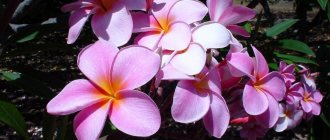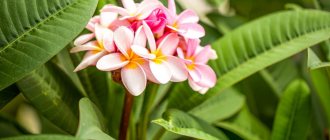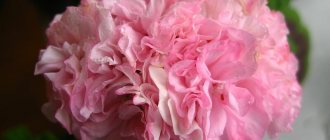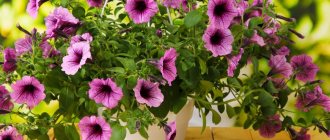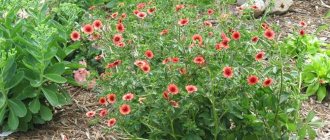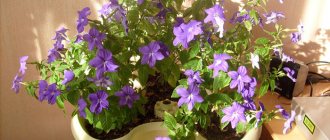The plant comes from South America, from where it was brought and first propagated by the French breeder C. Plumer (XVII century), hence the name Plumeria from the Kutrov family.
The plant is unique for its various representatives: bushes and trees. Flower growers strive to grow plumeria because of the beautiful delicate flowers of white-pink or yellow.
Flowering lasts all summer, the flowers themselves are large up to 10 cm. They are rare, because the plant grows up to 2 m, more often it can be seen in greenhouses.
Light
Plumeria loves light very much; it only needs southern windows, even in the greenhouse. It needs more than 6 hours of sun a day, otherwise the plant will not bloom. As a last resort, you can grow on the east or west side.
When it warms up, you need to take the plant outside, but getting used to direct sunlight should be gradual.
Important! Drafts and rain are excluded and should be brought into the house. From a sudden transition from the apartment to the sun, the leaves can get burned.
Diseases and pests
Plumeria sheds its leaves. If plumeria has dropped its leaves before the arrival of winter, then do not be alarmed - this is a natural phenomenon.
Plumeria does not grow. If the plant stops growing, the leaves lose turgor, droop, turn yellow, or fall off - most likely the plumeria is not watered enough.
The plumeria is rotting. If you add rotting stems and roots to the above symptoms, then most likely the watering is too abundant.
Plumeria pests. The main enemy of plumeria is the spider mite.
Watering
Indoors should be watered after the top layer of soil has dried with soft water (settled). Then plumeria flowers will give you aesthetic pleasure.
In winter, reduce watering, do not overdry the soil.
Excess moisture is also harmful, so be careful when watering.
Briefly about cultivation
- Flowering: lasts almost all summer from late spring.
- Lighting: bright sunlight: for the plant to bloom, it needs to be in direct sunlight for at least 6 hours every day.
- Temperature: from mid-spring to autumn - 25-30 ºC, in the fall the temperature is gradually lowered, and the plant should spend the winter at 16-17 ºC.
- Watering: moderate, in spring and summer - as the top layer of soil dries, in winter it is enough so that the earthen ball does not dry out completely.
- Humidity: high. It is recommended to keep the plant pot on a tray with wet pebbles and spray the leaves with warm water in the morning and evening in hot weather.
- Feeding: with the appearance of the first young leaves - twice a month with mineral fertilizer for flowering plants. From the beginning of autumn, fertilizing is gradually reduced, and in October it is stopped completely.
- Dormant period: 1-1.5 months from mid-October to March. The plant sheds its leaves before retiring.
- Pruning: after leaving the period, based on the fact that flowers are formed at the ends of the shoots of the current year.
- Transplantation: early spring: young plants - annually, adults - once every two years.
- Substrate: two parts of turf soil and one part each of humus, peat soil and sand.
- Reproduction: seeds and cuttings.
- Pests: spider mites.
- Diseases: rot of the stem and roots, untimely falling of leaves as a result of improper conditions and insufficient care.
- Properties: plumeria juice is poisonous!
Read more about growing plumeria below.
Air humidity
Systematic spraying is recommended during active growth. Soft water that has stood for a day is ideal for watering and spraying.
To increase humidity, a little small pebbles (expanded clay) are poured into the pan, after which water (soft) is poured.
Important! The bottom of the container should not come into contact with the water in the pan. You need to spray the plant carefully; flowers do not like water.
Planting process
Some gardeners recommend planting each seed in a separate container, rightly citing the fact that plumerias do not like transplants. Others use wide flat boxes or plastic greenhouses, no less justifiably noting that in this case caring for the flower will be simpler and safer for it.
Important! The method of seed propagation of plumeria has a serious disadvantage (or advantage). The probability of repeating the varietal characteristics of the parent plant is practically zero, and the grown daughter plant will be unique
For seed propagation of plumeria domestica, experts recommend using red plumeria (Plumeriarumba) seeds.
Planting is done as follows:
- in the center of the container (pot) it is necessary to make a small hole in the substrate;
- Lightly insert the seed perpendicularly with the lionfish facing up (it should be completely buried in the ground or at least three-quarters, but the lionfish should be above the ground). Lightly press down the soil around the seed;
- moisten the substrate and cover with polyethylene or glass.
Quiet time
In apartments, plumeria needs rest for 3-6 weeks in winter. The leaves fall, and in the spring a new stage of growth and flowering begins.
Important! The poison in plumeria juice, if it gets on the skin, can cause severe irritation. Immediately hold the sore spot under running water for a long time.
What soil is needed for indoor Schlumbergera?
Decembrist is a unique plant, being a tropical cactus, it delights with bright blooms in the bitter December frosts. Schlumbergera is not fussy about caring, but is very attentive to the soil and pot. In order for the flower to bloom profusely, it must be provided with the correct soil.
Decembrist prefers nutritious but light soil with good breathability. The acidity of the soil should be between 5.5-6 pH.
In addition, to please the Schlumbergera, you should take care of high-quality drainage. If you buy soil at a flower shop, it is better to choose two types of soil at once - soil for growing cacti and universal soil. When planting Decembrist, they are mixed in a 1:1 ratio. Zygocactus needs such soil in order to maximally replenish its need for nutrients.
Proper selection of soil is very important for growing a tropical cactus, but another important factor is maintaining moderate soil moisture. Therefore, it should not be allowed to dry out. You also need to periodically loosen the soil to prevent a crust from forming.
Transfer
In March-April, a young tree is replanted every year, only an adult tree is replanted after 2 years. Choose a container slightly larger than the previous one (2-3 cm). When there is no suitable pot, you need to trim the roots by 5 cm.
The bottom of the container is covered 1/5 with drainage (broken brick, expanded clay or eggshells). Then add the mixture: peat, turf, humus and sand (1:2:1:1).
Caring for plumeria at home
Lighting
The optimal location for indoor plumeria plants is considered to be southern windows, since the plant will bloom only if it is exposed to direct sunlight for at least 6 hours a day. In principle, the plant grows well on both western and eastern windows. On the north side, the plant will not bloom due to lack of lighting. Indoor plumeria can be taken out into the garden in the summer, but the plant must be gradually accustomed to direct rays, and must also be protected from drafts and precipitation. Also, do not place the plant in the sun immediately after purchase - burns may appear on the leaves.
Temperature
From mid-spring and throughout the summer, the plumeria plant requires high temperatures - from 25 to 30 °C. In autumn, the temperature is gradually reduced, and in winter it should not be lower than 16 °C.
Watering plumeria
In spring and summer, indoor plumeria is watered immediately after the top layer of soil has dried. Water the plant with soft, settled water. In winter, watering is reduced, making sure that the earthen ball does not dry out. Water should not stagnate in the pot - this can destroy the plant, so when the temperature drops or on inclement days, water the plumeria very carefully.
- Agapanthus (Agapanthus) – care, photos, types
Spraying
The plumeria plant at home responds very well to spraying during the growing season. You need to take soft water for spraying and let it stand for at least a day before spraying. You can also place the pot on a tray with wet pebbles or expanded clay, making sure that the water in the tray does not touch the bottom of the pot. Water should not get on the flowers.
Top dressing
After new leaves begin to appear in the spring, the plant is fed with complex fertilizers. After this, plumeria is fed with fertilizers for flowering plants twice a month. If the plant stands outside in the summer, then every other time the plumeria can be fertilized using a foliar method - the fertilizer is diluted to half the concentration suggested by the manufacturer and the leaves are sprayed on both sides. They do this in the evening once a week or a week and a half. With the arrival of autumn, the frequency of fertilizing is reduced, and in winter it is stopped altogether.
Rest period
When growing plumeria indoors in winter, the plant goes dormant - depending on the type of plant, dormancy lasts 3-6 weeks. At this time, the plant usually sheds only its old leaves, while the younger ones remain on the tree. At the end of the dormant period, new leaves and flowers begin to appear on the plants.
Trimming
When the plant comes out of dormancy, it needs to be pruned. When forming the crown of plumeria, you need to take into account that flowers appear at the ends of shoots that grew in the same year. For pruning, use a very sharp knife or pruning shears, which must first be treated with alcohol. Cut branches can be used for propagation by cuttings.
Plumeria transplant
Plumeria flowers are replanted in early spring: young trees every year, and older trees once every two years. The pot should be 2-3 cm larger than the previous one. If there is no larger pot, then you can trim the roots by 5 centimeters and fill the remaining space in the pot with fresh substrate. The soil is made up of turf, peat, humus soil and sand (2:1:1:1). At the bottom you need to pour expanded clay or broken bricks to 1/5 of the height of the pot. Some gardeners use eggshells instead of expanded clay.
Growing from seeds
Seeds are sown in pots 6 cm in diameter. When shoots appear and the root system gets stronger, the young plants are transferred to 9-centimeter pots. The soil mixture used is the same as when transplanting plumeria. Plants grown from seeds usually look different from the parent plumeria. Home plumeria usually begins to bloom in the second or third year.
- Peach: growing in the garden, types and varieties
Propagation by cuttings
Cuttings for propagation should be cut at an oblique angle, and it is best in late winter - early spring. The cut site is dipped in water and then in a root formation stimulator. A plumeria cutting is planted in a cunning way: the pot is filled in three layers - a third with soil mixture (described above), a third with perlite and again with soil mixture. The cutting is placed vertically so that its lower end is completely covered in perlite. It is advisable to use bottom heating, because... the temperature for normal rooting should be 25-28 °C. Provide bright lighting (fluorescent lamps if necessary) and water carefully. The appearance of leaves indicates the rooting of the plumeria cuttings - this usually occurs after 2-3 months. Watering is gradually increased, then transferred to a large pot and cared for as an adult specimen. Flowers usually appear the next year, or maybe the same year.
Virulence
Plumeria juice is poisonous and can cause irritation if it comes into contact with mucous membranes or skin. If the juice gets on the skin or mucous membrane, you should immediately rinse the area with plenty of clean running water.
Propagation by cuttings
In the last weeks of winter, cuttings can be carried out in early spring. Cut only at an oblique angle. Then wet the cut with water and in a solution, which activates the formation of roots.
The pot is first filled with the mixture (for replanting), 1/3 with perlite, then again with the mixture.
When planting, the cut of the cutting should be in perlite.
The optimal temperature for the development of a young plant is +25-28o C. Good lighting and maintaining stable heat are a must. A fluorescent lamp will do.
Muraya: types, description, care and cultivation at home. 140 photos and video instructions for maintaining a bush- Tea tree: growing at home. Indications and contraindications for the use of medicinal plants (115 photos + video)
Clerodendrum: proper care at home and the nuances of maintaining a shrub (130 photos + video)
Leaves appear after 10-12 weeks, then watering is increased. You will be able to see blooming plumeria in a year, sometimes earlier.
General information
Therefore, despite the rarity on sale and the large size of some varieties and species (up to 2 meters in height), plumeria is highly valued in home gardening and decorative design of greenhouses.
In addition, plumeria essential oil is widely used not only in the manufacture of perfume, but also in other industries. It is also widely distributed in the form of an oil essence, and plumeria oil is distinguished by its amazingly rich aroma.
Frangipani oil is expensive and is used in the manufacture of plumeria perfumes, soaps, as well as in cooking, adding to salads, the taste and aroma are exquisite.
Plumeria oil also has medicinal properties with a calming effect, producing a feeling of euphoria. The use of plumeria soap provides anti-inflammatory effects.
Varieties
Plumeria alba is found in the Antilles, up to 10 m tall, has fragrant flowers and narrow leaves.
Red plumeria grows in Mexico and Venezuela up to 5 m with larger leaves and flowers of various colors: snow-white, pink, bright yellow and red.
An exotic tree with delicate flowers of various shades and a wonderful aroma will bloom for a long time.
The photo shows plumeria of different types and varieties.
Botanical description
Plumeria (lat. Plumeria) is a plant that is part of the Kutrov family and has about 65 species of plants. The genus was named in honor of Charles Plumer, a famous botanist in France in the 17th century. Under natural conditions, the plant lives in the north of South America. Representatives of the genus are shrubs or small trees. Homemade plumeria is valued for its flowers - white, pinkish, yellow. But the most important thing is the aroma of these flowers. Plumerias bloom almost all summer. The flowers are large - up to 10 cm in diameter. In our latitudes, plumeria is grown quite rarely, which is why it is not easy to buy plumeria. In indoor conditions, the plant can reach a height of 2 m, although it is optimal to grow plumeria in greenhouses.
Photo of plumeria
How to choose a ready-made substrate
It is best to purchase a ready-made substrate at a gardening store rather than rack your brains over the question of what soil is needed for spathiphyllum and how to make it yourself.
Nowadays, it is not so difficult to find special soil for the flower of female happiness in stores. One of the suitable options is Vermion soil mixture. If you cannot find soil for spathiphyllum, a soil mixture for tropical plants or aroid crops is suitable. If you don’t find such soil mixtures, you can buy a universal soil, but you will have to carefully study the composition before purchasing and add additional ingredients.
It is better to choose a substrate whose packaging says that it is for spathiphyllum
What kind of soil is needed for spathiphyllum:
- Universal primer for the aroid family Seliger-Agro. The acidity level of this substrate is within 5-6. The composition includes river sand, peat, expanded clay, large-pored baking powder and a complex of mineral fertilizers specially selected for this group of plants.
- Another good substrate is BioMaster. The composition includes moss, biosoil, sand and charcoal.
- The substrate from Eco Sad is also suitable for planting the flower of female happiness. It consists of sand, moss, turf soil, peat, vermicompost, charcoal, agroperlite. All ingredients are laid in layers. You can mix them at your discretion.
Important! Universal soil mixtures usually have a high level of acidity and are too heavy for aroid crops. But store-bought soil mixtures are not always suitable for plants.
After transplantation, the first time you need to monitor the flower. And if it looks bad, you need to change the soil
But purchased soil mixtures are not always suitable for plants. After transplantation, the first time you need to monitor the flower. And if it looks bad, you need to change the soil.
What can be added to purchased soil to improve it?
If you can’t find a soil with a suitable composition, you will have to buy a universal soil mixture and add other ingredients to it to improve it.
Before planting, sand, wood ash, coconut shavings, crushed tree bark or perlite are added to the universal soil for spathiphyllum.
Feeding
The application of additional fertilizers is an important condition for growing. To ensure active flowering, the formation of a beautiful crown and the growth of the crop, the soil in the pot is watered with mineral preparations from the flower shop. Some fertilizers are designed for spraying leaves. Experts recommend feeding the soil in the spring before flowering or in the fall during fruit formation. Active growth of buds is ensured by fertilizing with phosphorus and nitrogen. It is advisable to alternate foliar and root fertilizers once every 2-3 weeks. During the dormant period in winter there is no need for this.
Beneficial properties of frangipani
Photo of plumeria
The shrub, like many representatives of the Kutrov family, is poisonous. Its juice causes severe skin irritation. When working with bushes, you should wear gloves. However, the appearance of plumeria is very pleasant.
Its purification of the surrounding air and the vitality of the plant are undoubtedly beneficial. In Thailand it is believed to have magical powers. When used for ritual purposes, the plant is believed to attract good luck and prosperity and provide immortality.
